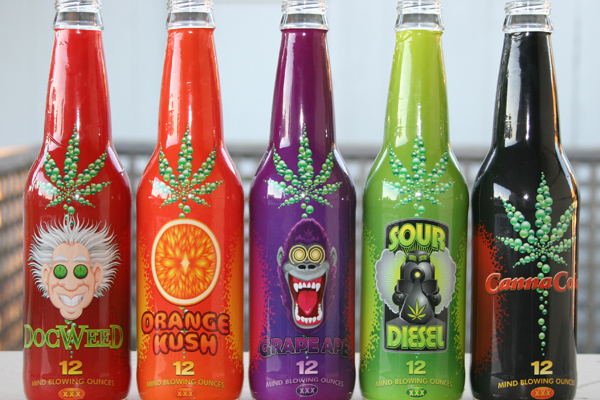Pot Soda vs. Four Loko: Which is More Dangerous?

Just as America's stash of black-market Four Loko dwindles, a new form of intoxicating soda has risen like a phoenix from its ashes: pot-laced soda. But while Four Loko has been recalled amid reports of alcohol poisoning and accidental deaths, the worst side effect of overdoing it with marijuana soda might just be a really bad tummy ache. California-based entrepreneur Clay Butler has developed a line of cannabis soft drinks that will hit the shelves of medical marijuana dispensaries in Colorado in February and California in the spring. Each 12-ounce beverage which will come in such varieties as Canna Cola, Doc Weed and Orange Kush will contain 35 to 65 milligrams of the psychoactive ingredient in marijuana, tetrahydrocannabinol (THC). But how much is that compared with, say, the amount of the drug in a marijuana joint? And how does Canna Cola's intoxicating effects stand up to Four Loko? According to a report by the World Health Organization, a typical marijuana joint may contain anywhere from 5 to 150 mg of THC, and only a fraction of that 2 or 3 mg is required to produce a brief, pleasurable high for the occasional user." On the other hand, "heavy users in Jamaica, for example, may consume up to 420 mg of THC per day." This means the drug content of a Canna Cola, though a mere mid-morning snack for a Rastafarian, is 10 to 30 times that required to get most people high. Joshua Lile, a pharmacologist in the department of behavioral science at the University of Kentucky who studies drug addiction, said the dosage in a Canna Cola is indeed quite high, and that it might be even higher than it seems when compared to a joint. "When you ingest THC orally, it's much more potent than when you smoke it," Lile told Life's Little Mysteries. "Active metabolites such as 11-hydroxy-delta-9 THC get produced in the liver and intestines when you metabolize the drug, and these add to the effects it has on the brain." Few studies have ever used more than 30 mg of orally administered THC, making the 35-65 mg in a Canna Cola "a pretty high dose for a single beverage." However, Lile explained that this doesn't necessarily mean the pot sodas are dangerous: "THC exhibits what's known as a 'flat dose effect curve'. Once you hit a peak dose you don't see much change in how high people become. For example, I've administered up to 90 mg of THC to study subjects. Some get sick to their stomachs at around 30 mg, but experienced marijuana users can handle much more." Rather than becoming super high, then, a Canna Cola-drinker may just be in danger of becoming really sick to his stomach. "The effects of orally ingested marijuana take a while to set in," Lile said. "You may drink one, then be sitting around waiting for something to happen and then decide to drink another one. Depending on your absorption level (which varies a lot between people), you could feel really nauseated." This is not the worst-case scenario, however, that results from drinking too much of the alcoholic energy drink Four Loko. Until its manufacturers decided to re-formulate the drink last November in response to an FDA warning, each 23.5-ounce can of Four Loko contained 12 percent alcohol by volume and 135 mg of caffeine. That made drinking one can roughly the equivalent of downing four regular beers and a large coffee, all hidden behind a fruity taste. Several states banned sales of the beverage after its frequent involvement in cases of alcohol poisoning and death on college campuses. Lile said, "In general, if you're going to compare the two, performance impairments are less severe from cannabis than they are from alcohol."
Got a question? Send us an email and we'll look for an expert who can crack it.
Follow Natalie Wolchover on Twitter @nattyover.
Sign up for the Live Science daily newsletter now
Get the world’s most fascinating discoveries delivered straight to your inbox.
Natalie Wolchover was a staff writer for Live Science from 2010 to 2012 and is currently a senior physics writer and editor for Quanta Magazine. She holds a bachelor's degree in physics from Tufts University and has studied physics at the University of California, Berkeley. Along with the staff of Quanta, Wolchover won the 2022 Pulitzer Prize for explanatory writing for her work on the building of the James Webb Space Telescope. Her work has also appeared in the The Best American Science and Nature Writing and The Best Writing on Mathematics, Nature, The New Yorker and Popular Science. She was the 2016 winner of the Evert Clark/Seth Payne Award, an annual prize for young science journalists, as well as the winner of the 2017 Science Communication Award for the American Institute of Physics.










